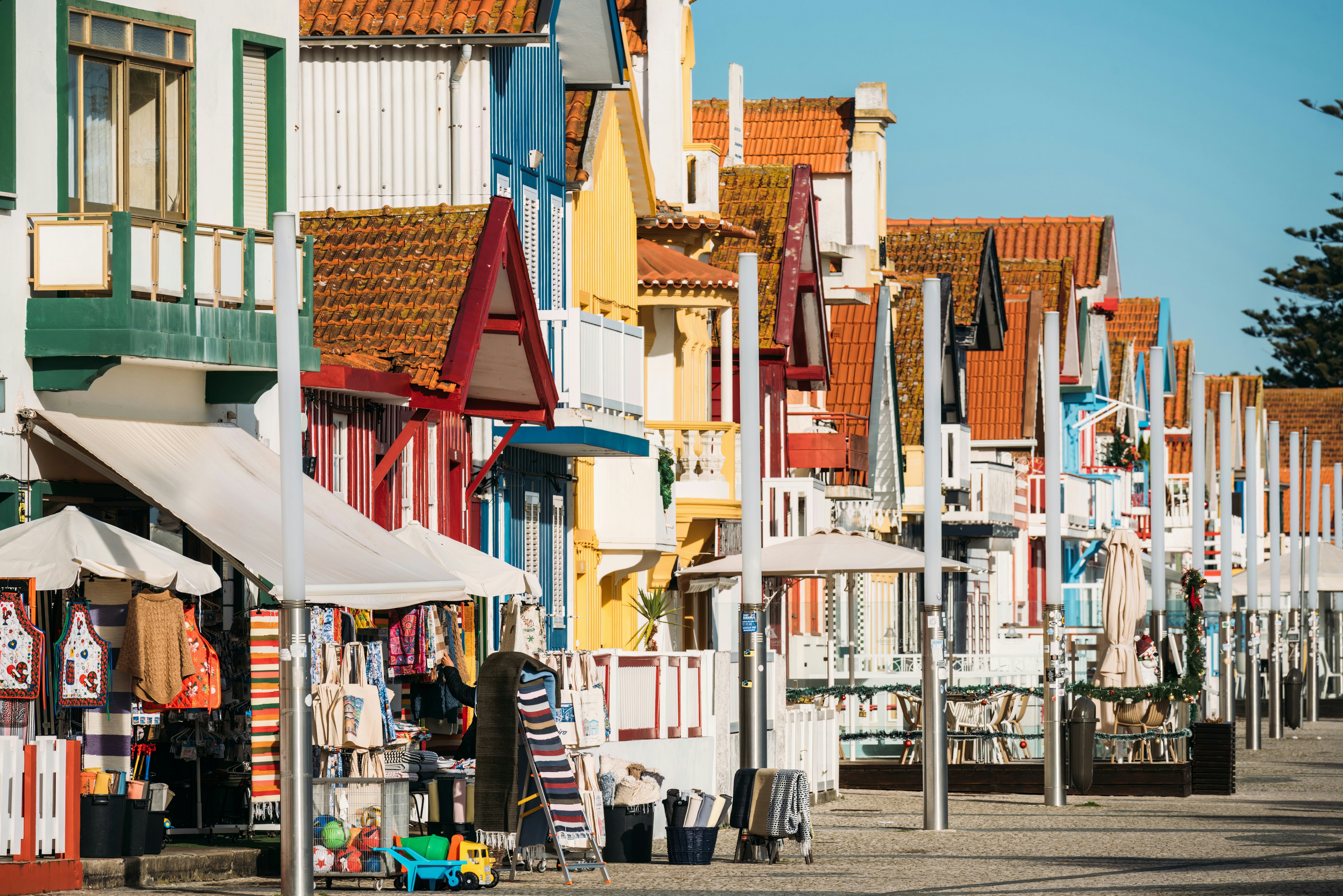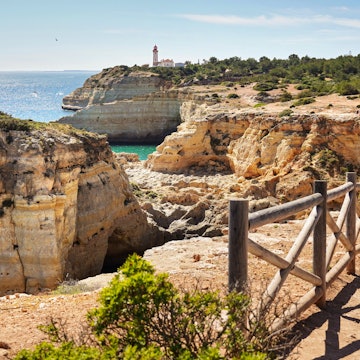
Day trips from Porto for sipping wine, learning Portuguese history and celebrating

Jul 5, 2025 • 6 min read

Vineyards in Pinhão, Portugal, in the Douro Valley. Agnieszka Skalska/Shutterstock
Porto pulls you in with its historic streets, riverside walks backed by sunset tunes, and an undying love for sandwiches. But as much as it’s nice to linger here with a Port tonic in hand, there’s a whole world to see just outside the city’.
A train whisks you through the middle of the Douro Valley, where vineyards grow in steep terraces, to the heart of medieval towns that were once the country’s capitals, and down the coast where windswept beaches await. Whichever direction you choose, here’s our pick of the best day trips from Porto.
1. Feast on cheeky sweets and vinho verde in Amarante
Travel time: 40 minutes
Amarante may be a small town, but it’s worth the pit stop just for the food alone. I like to hop around the tascas of Rua 31 de Janeiro, munching on juicy cured ham sandwiches and sipping glasses of vinho verde costing less than a fiver. Despite the name, vinho verde (green wine) isn’t green – it’s basically young Portuguese wine that can be red, white or even rosé, and Amarante has a selection of it all! Another popular treat here is the phallic-shaped sweet sold in pastry shops like Confeitaria Lailai. (Don’t be afraid to point.) Every year, locals gift one of these as a symbol of good fortune. Food aside, there are only a handful of attractions here – including the Museu Municipal Amadeo de Souza-Cardoso, a contemporary art museum dedicated to the namesake Portuguese modernist painter, and a 16th-century church – all easily covered in half a day.
How to get to Amarante from Porto: Rede Expressos provides regular buses from Porto’s Campanhã bus terminal to Amarante.

2. Enjoy the churches and coffee culture of Braga
Travel time: 40 minutes
Braga has the biggest collection of churches in Portugal, including the country’s oldest cathedral. When Holy Week comes around, the whole city becomes a pilgrim magnet. Even if you’re not a devotee, it’s worth visiting the Santuário do Bom Jesus do Monte, a striking Baroque sanctuary sitting at the top of 500-plus stairs. (Don’t worry, there’s a funicular ride available.) What I like most about the city, however, is its laid-back coffee culture. From the century-old A Brasileira to the bookstore café of 100º Página, there are plenty of spots to hunker down with a brew. Or you can switch things up with a local craft beer from Letraria. Braga is also the perfect jumping-off point to explore the wilderness of the Gerês National Park, a bus ride away.
How to get to Braga from Porto: You can easily reach Braga by train or bus.
3. Capture Portugal’s medieval soul in Guimarães
Travel time: 40 minutes
Before Lisbon took the capital title, Guimarães was first on the list. This Unesco-listed medieval town still feels kind of frozen in time with its maze of stone houses and a crenelated castle looming on a hill. The Paço dos Duques de Bragança offers a glimpse of what would have been a rich royal settlement – think Flemish tapestries, porcelain, and antique furniture. When it comes to food, you can splurge on modern fine dining in places like A Cozinha or Le Babachris, but also kick back at Taberna Trovador with wine and a round of petiscos or at one of the many student haunts.
How to get to Guimarães from Porto: Guimarães is accessible by train or bus from Porto Campanhã.

4. Sail the canals of Aveiro
Travel time: 40 minutes to 1 hour
A string of canals surrounds the city of Aveiro, just south of Porto. You can navigate these by hopping on a moliceiro, a colorful boat once used to carry seaweed, but now transformed into a tourist attraction. The panels drawn across the bow and stern have somewhat suggestive depictions, but you can also get the classic image of Amália (the queen of fado) thrown in there, too. Aveiro is equally known for its Art Nouveau architecture, freshly caught oysters (try them at Ostraveiro), and ovos moles, a sweet delicacy combining egg yolk and sugar wrapped in wafer-like cases with sea motifs. Confeitaria Peixinho has been dishing out boxes of these since 1856! With a bit more time, you can venture further to Costa Nova, a seaside town famous for its row of colorful striped cottages, or tour the ceramic factory at Museu Vista Alegre.
How to get to Aveiro from Porto: Aveiro can be reached by train or bus. Trains leave from São Bento and Campanhã stations, though you’ll have more options from the latter. Buses also leave from the Campanhã terminal.

5. Party with the students of Coimbra
Travel time: 1 hour
Students in black capes roam the streets of Coimbra all year round. This university town really comes alive in late May during the graduation festivities known as Queima da Fitas. Thousands gather for the one-week celebration, which includes traditional music performances. But even on most nights, you can hear a group bursting out a fado tune in a city square (or you can head to Fado ao Centro for the regular daily show). Parts of the university grounds are open to visitors, including the Biblioteca Joanina, a Baroque library that holds over 40,000 titles. From here, you can reach a variety of other attractions, including medieval churches and Coimbra’s peaceful parks and gardens. And if you’re up for an adventure, you can always kayak down the Mondego River.
How to get to Coimbra from Porto: There are direct trains from the Campanhã station to Coimbra-B on the outskirts of town. Alternatively, you can get the Rede Expressos bus, which stops slightly closer to the center.
6. Marvel at the terraced vineyards of the Douro Valley
Travel time: 2 hours and 30 minutes
Portugal has some extraordinary wine regions, but when it comes to the landscape, the Douro Valley is pretty hard to beat. Those steeply terraced vineyards are a sight to behold, whether you’re down by the river sailing amid them on a quiet solar boat (my personal favorite) or up on one of the quintas taking in the views with a wine in hand. A visit to the Museu do Douro in Peso da Régua is a must if you want to learn more about the history of the region. But if you’re picking a place to base yourself, Pinhão is always a safe bet. There are a handful of estates here, outstanding viewpoints like Miradouro Casal De Loivos, plus some good restaurants like Veladouro, which serves delicious meat on the grill. With a car, your options are endless, but you’ll have to go light on the tastings.
How to get to the Douro Valley from Porto: Several trains depart from the São Bento train station to Régua or Pinhão, two easy gateways to the Douro Valley. In summer, you can book the steam train for a change of scenery. It’s also possible to drive along the valley following the scenic road N222.















